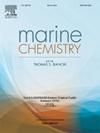Microplastics in wild Saccostrea cucullata oysters in Sri Lanka: Pollution status and risk assessment
IF 3
3区 地球科学
Q2 CHEMISTRY, MULTIDISCIPLINARY
引用次数: 0
Abstract
Microplastics (MPs) have widely been reported in many marine organisms that cause significant environmental concern. Oysters are known to accumulate MPs through their filter-feeding mechanism yet studies focused on MPs pollution in oysters along with ecological risk assessment are scarce. In this study, we investigated MPs pollution in wild Saccostrea cucullata oysters and assessed the ecological risk of MPs pollution in oysters and their habitats along the southern and western coasts of Sri Lanka. Oyster MPs abundance varied from 0.63 to 2.20 particles g−1 wet weight (ww), which showed a significant positive correlation with MPs abundances in surrounding surface seawater and surface sediment. The average MPs abundances in oysters, surface seawater and surface sediment showed significant spatial differences where high MPs abundances were reported in areas that had high anthropogenic activities. Size classification of MPs revealed that small size (100 μm-1 mm) blue fibres were dominant in oysters, surface seawater and surface sediment likely due to the high abundance of discarded fishing nets in studied areas. The abundance of various polymer types indicated that low-density polyethene polymers were most abundant (oysters, 45.74 %; surface seawater, 42.91 % and surface sediment, 39.62 %). Results of the ecological risk assessment indicated that MPs pollution in the environment was low (Level I). However, MPs pollution in oysters ranged from low to moderate risk levels (Level I-II), where moderate risk was reported in the areas with high MPs contamination. Therefore, our study highlights that mitigation of MPs pollution on the southern and western coast of Sri Lanka is important to alleviate the increasing ecological risk of MPs pollution in Saccostrea cucullata.
斯里兰卡野生 Saccostrea cucullata 牡蛎中的微塑料:污染状况和风险评估
微塑料(MPs)在许多海洋生物中被广泛报道,引起了重大的环境问题。众所周知,牡蛎会通过其滤食机制积累 MPs,但有关牡蛎中 MPs 污染以及生态风险评估的研究却很少。在这项研究中,我们调查了斯里兰卡南部和西部海岸野生 Saccostrea cucullata 牡蛎中的 MPs 污染情况,并评估了 MPs 污染对牡蛎及其栖息地造成的生态风险。牡蛎的 MPs 丰度在 0.63 至 2.20 微粒 g-1 湿重(ww)之间变化,与周围表层海水和表层沉积物中的 MPs 丰度呈显著正相关。牡蛎、表层海水和表层沉积物中 MPs 的平均丰度显示出明显的空间差异,在人为活动频繁的地区 MPs 丰度较高。MPs的尺寸分类显示,在牡蛎、表层海水和表层沉积物中,小尺寸(100 μm-1 mm)蓝色纤维占主导地位,这可能是由于研究地区存在大量废弃渔网。各类聚合物的含量表明,低密度聚乙烯聚合物含量最高(牡蛎,45.74%;表层海水,42.91%;表层沉积物,39.62%)。生态风险评估结果表明,环境中的多溴联苯醚污染程度较低(I 级)。然而,牡蛎中的 MPs 污染程度从低到中度不等(I-II 级),其中 MPs 污染程度较高的地区报告了中度风险。因此,我们的研究强调,斯里兰卡南部和西部沿海地区必须减轻 MPs 污染,以缓解 Saccostrea cucullata 不断增加的 MPs 污染生态风险。
本文章由计算机程序翻译,如有差异,请以英文原文为准。
求助全文
约1分钟内获得全文
求助全文
来源期刊

Marine Chemistry
化学-海洋学
CiteScore
6.00
自引率
3.30%
发文量
70
审稿时长
4.5 months
期刊介绍:
Marine Chemistry is an international medium for the publication of original studies and occasional reviews in the field of chemistry in the marine environment, with emphasis on the dynamic approach. The journal endeavours to cover all aspects, from chemical processes to theoretical and experimental work, and, by providing a central channel of communication, to speed the flow of information in this relatively new and rapidly expanding discipline.
 求助内容:
求助内容: 应助结果提醒方式:
应助结果提醒方式:


